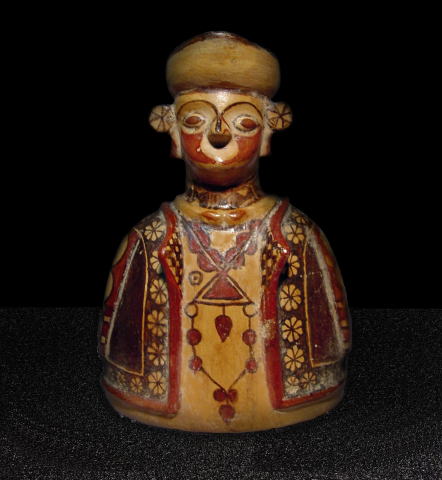 |
Taiyo Ltd.
2-11-9, KYOBASHI, CHUO-KU, TOKYO 104-0031 JAPAN.
TEL: 03-5524-6066 |
|
 |
|
Pottery Figure Wearing Chapan
Afghanistan, Post-Sasanian, 7th century AD, pottery
Height: 23.5 cm
This pottery figure was found in the northern part of Afghanistan that was culturally integrated with Sogdiana. Sogdiana was strongly influenced by art of Sasanian Persia and inherited its design. Shapes and patterns of that pottery reflect rich creative abilities. Some of the vessels are in the shape of a bird or a person wearing folk costume called chapan, like this piece of pottery, others have an ordinary jar-like body, but the spout is in the shape of an animal, bird or human head, while others are just ordinary jars. Painted decoration consists of motifs originated in Sasanian Persia, but modified by the culture of Sogdiana. Sasanian design was a combination of geometric patterns with floral and animal motifs. When it comes to Sasanian and Sogdian design, a pearl roundel is a typical example.
|
Dots formed the pearl roundel when arranged in circles, but were also arranged in straight lines, hearts arranged in rosettes, four-lobes or diamonds, all those patterns are said to be derived from the decoration of crowns and jewelry. Animal motives included deer, wild boars, sheep, but also fantastic beasts like winged sheep and winged horses, and the fantastic animal Senmurv, as well as birds like ducks, peacocks, roosters, and eagles. Most of the animals used in the design appeared in Persian legends and were symbolic of both religion and royal power, which were so closely related that they could not be considered separately. However, even if the Sogdian design influenced by the Sasanian tradition used the pearl roundel and fantastic animals design for textiles and vessels, the same iconography was reborn as a novel and dynamic one. Another important motif - the ribbons dated back even further to the Parthian period (c. 250 BC ~ 224 AD), is thought to have originated from the ribbon attached to the crown depicted in the scenes of a king receiving royal authority from the Zoroastrian gods.
It is not certain whether the dark color of this person's cheeks represented a beard or a tattoo. The necklace is of size similar to modern local accessories, and it reminds precious stones and metals being mined in Afghanistan. |
|
|
| ←BACK |
|